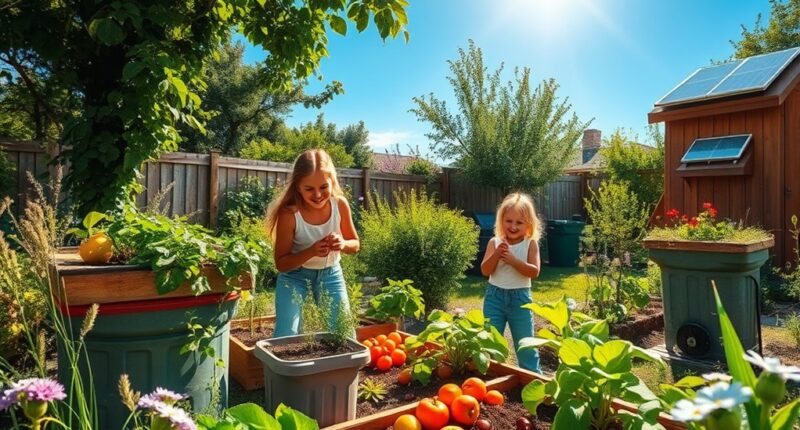Green living is all about making choices that benefit both your family and the planet. Start by reducing waste with the 3 R’s: reduce, reuse, recycle. Switch to energy-efficient appliances and LED bulbs to save on energy costs. Use public transport or cycle whenever possible to cut emissions. Shop sustainably, opting for eco-friendly products and bulk items. By adopting these eco-friendly practices, you’ll create a healthier environment for your loved ones and discover even more ways to contribute positively.
Key Takeaways
- Embrace the 3 R’s: Reduce, Reuse, and Recycle to minimize waste and promote eco-friendly habits within the family.
- Involve children in energy-saving tasks, such as turning off lights and unplugging devices, to foster a culture of conservation.
- Utilize public transport, cycling, or walking for short distances to reduce emissions and promote healthier lifestyles.
- Organize community workshops on sustainable living practices to engage families in eco-friendly initiatives and shared resourcefulness.
- Prioritize purchasing sustainable products and materials to support environmentally responsible consumption and reduce the family’s carbon footprint.
Understanding the Importance of Sustainability

Understanding the importance of sustainability is essential, especially as we face unprecedented environmental challenges. Over 50% of the world’s GDP relies on nature, making economic vulnerability to biodiversity loss a pressing issue. You might be surprised to know that 75% of executives believe sustainability drives better business outcomes, reflecting its central role in today’s operations. With 72% of consumers willing to pay more for sustainable products, there’s a growing market for eco-friendly options. Yet, if we don’t adapt to climate change, we risk annual GDP losses of up to 4.4%. Embracing sustainability isn’t just about protecting the planet; it’s about securing our economic future and ensuring a healthier, more resilient world for generations to come. Global greenhouse gas emissions increased by 50% over the last 30 years due to fossil fuel use. Furthermore, eco-friendly accommodations like eco-lodges provide a sustainable option for travelers, highlighting the importance of responsible tourism in preserving our environment. Additionally, the loss of biodiversity can lead to ecosystem collapse, affecting food security and human health. Moreover, investing in renewable energy technologies can significantly contribute to reducing carbon footprints and promoting sustainable economic growth. The development of renewable energy sources is projected to surpass fossil fuels in usage, indicating a pivotal shift towards sustainable energy practices. Heat pumps are a prime example of how renewable energy solutions can improve home efficiency and lower emissions, playing a crucial role in achieving sustainability goals.
Practical Steps for Reducing Consumption
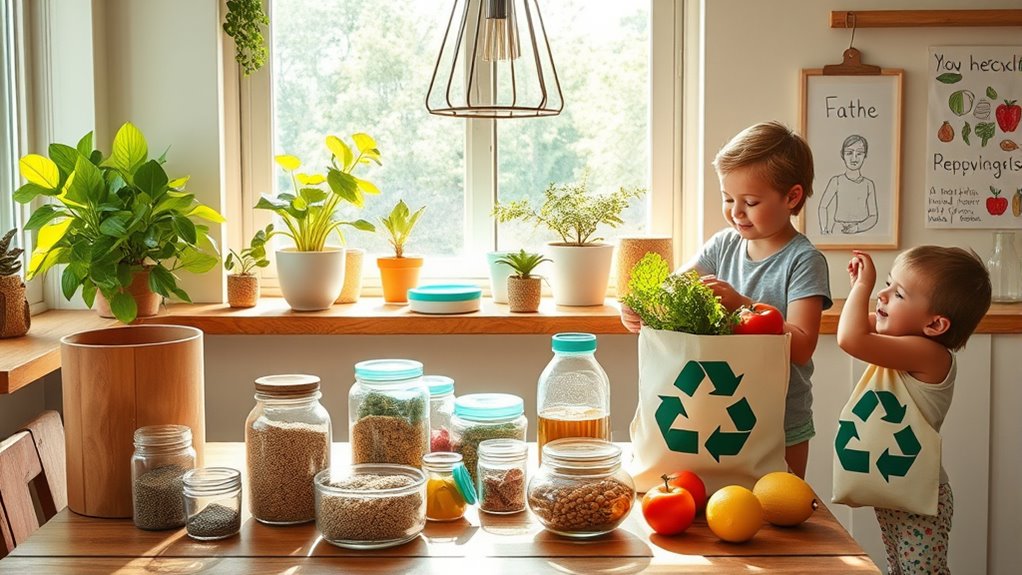
As you endeavor to live more sustainably, reducing consumption is an essential step that can greatly impact the environment.
Start by implementing the 3 R’s: Reduce, Reuse, and Recycle. Use reusable bags and containers to cut down on plastic waste, and steer clear of single-use items like plastic straws. Incorporating making a list of essential items before shopping can help you avoid unnecessary purchases and reduce impulse buying. Additionally, consider using essential oils in your home for a natural way to enhance your environment. Practicing self-reflection can also help you identify areas where you can further reduce consumption. Furthermore, embracing sustainable materials in products you buy can contribute to a more eco-friendly lifestyle. It’s also beneficial to choose toys made from natural materials to ensure both safety and sustainability for your children. Including chia seeds in your diet can provide health benefits while promoting a sustainable lifestyle.
Meal planning helps reduce food waste, while repurposing old items keeps them out of landfills. When shopping, consider buying second-hand or products made from recycled materials.
Opt for bulk purchases to lessen packaging waste and support local farmers for fresher, seasonal produce.
Finally, assess your consumption habits—use what you have, donate unused items, and prioritize quality over quantity to make a difference.
Energy Conservation Tips for Families
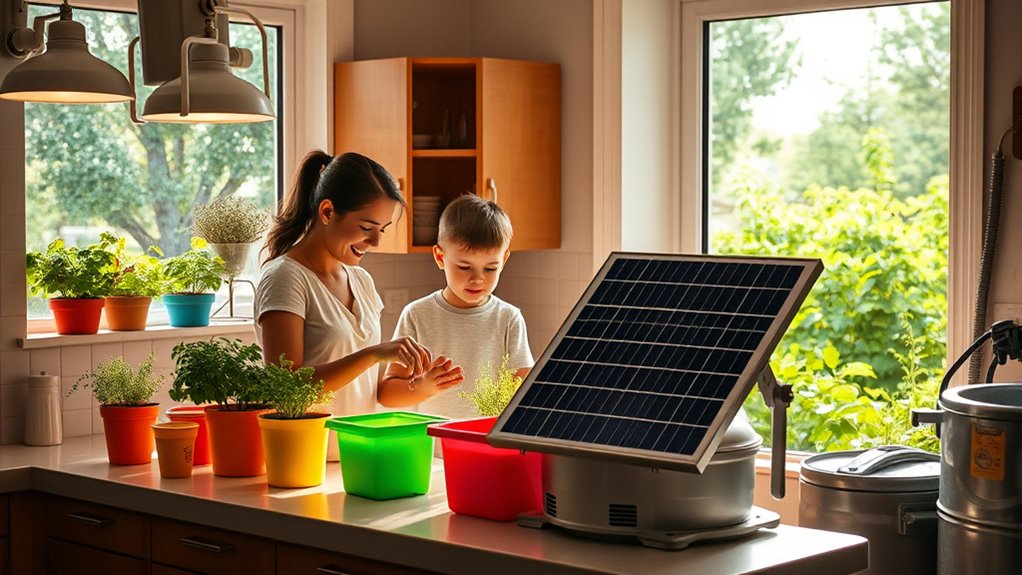
Reducing consumption is just one part of a broader approach to sustainable living; energy conservation plays a key role in minimizing your family’s environmental footprint.
Start by turning off lights and unplugging devices when they’re not in use to prevent phantom power consumption. Switch to LED bulbs to cut energy use markedly. Monitor your thermostat settings and consider upgrading to a programmable thermostat for better efficiency. Additionally, keeping windows and blinds closed can help maintain a cooler home environment, reducing the need for air conditioning. Implementing energy-efficient systems like heat pumps can further enhance your home’s energy performance and reduce long-term costs, as these systems can lead to average savings on energy costs reaching up to 50%. Furthermore, commercial heat pumps can significantly reduce energy costs in larger residential settings. Remember that energy audits can also pinpoint specific areas in your home that need improvement. Furthermore, ensuring proper venting techniques in your home can further optimize your energy consumption while maintaining safety.
Limit screen time and opt for microwaves or toaster ovens for smaller cooking tasks. Encourage natural light by opening curtains during the day and sealing air leaks around windows and doors.
Involve your kids by assigning them roles in energy-saving tasks, making it a fun challenge to participate in conserving energy together.
Eco-Friendly Transportation Options
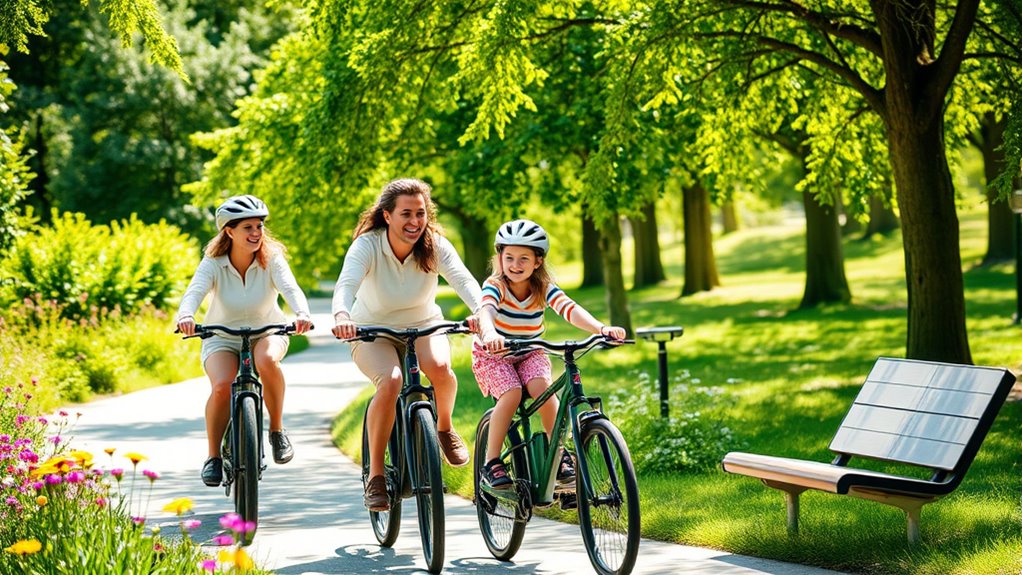
When it comes to eco-friendly transportation options, families can make a significant impact by choosing alternatives that prioritize sustainability.
Public transport, like trains and buses, cuts emissions and is often more economical than driving. For shorter distances, consider cycling or walking; these promote health and reduce your carbon footprint. Using public transportation can also be an adventure for children, enhancing their overall travel experience.
If you need to travel farther, electric vehicles offer a greener option with zero emissions. Carpooling and ride-sharing not only lower traffic congestion but also minimize the number of cars on the road.
Additionally, bike-sharing programs are convenient for quick trips in urban areas.
Sustainable Shopping Practices for Everyday Life
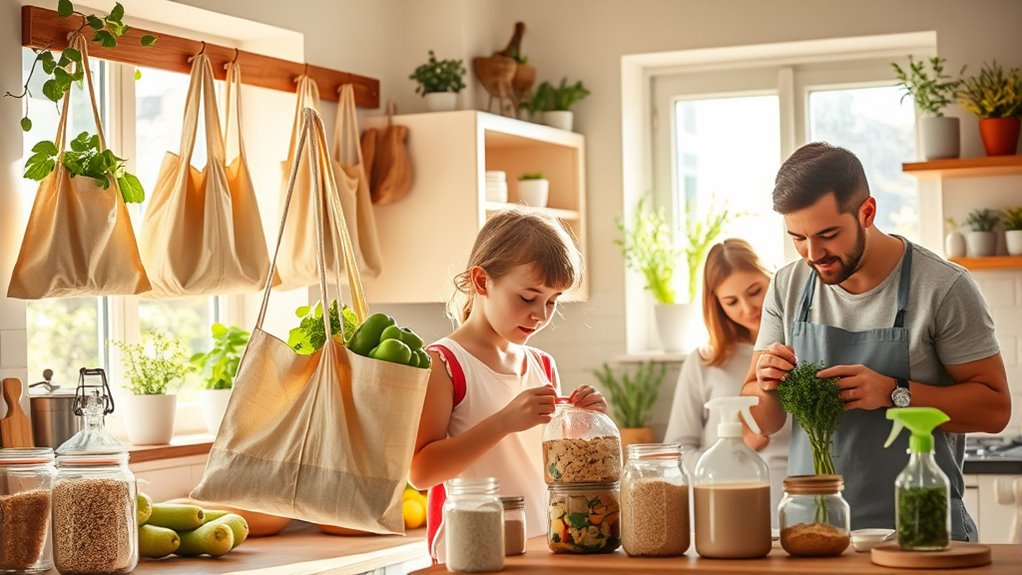
Incorporating sustainable shopping practices into your family’s daily routine can greatly reduce your environmental impact while promoting a healthier planet. Start by prioritizing quality over quantity, choosing high-quality items that last longer. Opt for eco-friendly materials and support brands that demonstrate transparency and ethical labor practices. Whenever possible, buy local to cut down on transportation emissions and boost your community. This approach aligns with eco-friendly minimalism principles that emphasize sustainable products to reduce environmental impact. Additionally, remember that sustainable living is not just about the products you buy, but also about the lifestyle choices you make.
Reduce waste by selecting products with minimal or biodegradable packaging, and consider bulk shopping to lessen packaging waste. Embrace secondhand options like thrift shopping and clothing swaps to minimize production demands. Moreover, consider using wood stoves as a sustainable heating option that supports eco-friendly practices. Understanding primitive weapons can also offer insight into sustainable tools for survival and resourcefulness.
Finally, educate your family on mindful consumption habits, emphasizing the importance of thoughtful purchases and recycling. Additionally, consider investing in high-quality materials like wood from sustainable sources, which can enhance durability and reduce environmental impact.
Frequently Asked Questions
How Can We Motivate Children to Embrace Green Living?
To motivate children to embrace green living, start by engaging them with fun, hands-on activities like planting a garden or participating in community clean-ups.
Use storytelling and educational films to spark their curiosity about environmental issues.
Model eco-friendly behaviors yourself, like recycling and conserving energy.
Create family rules around sustainability and involve them in decision-making.
When they see you practicing what you preach, they’ll be more likely to follow your lead.
What Are the Benefits of Sustainable Living for Families?
Sustainable living offers you and your family numerous benefits. It improves your physical health by reducing exposure to environmental hazards and enhances mental well-being through outdoor activities.
You’ll save money by cutting energy costs and minimizing waste. Plus, supporting local businesses fosters community connections.
Embracing sustainable practices encourages your children to develop environmental responsibility and empathy, creating a healthier, happier home for everyone while positively impacting the planet.
How Can Families Measure Their Environmental Impact?
Isn’t it ironic? You’re trying to reduce your environmental footprint, but you’ve got no clue how big it is.
Families can measure their impact using tools like Life Cycle Analysis to evaluate products or Carbon Footprint calculators to assess CO₂ emissions.
You could also use the Ecological Footprint to see resource use versus availability.
What Eco-Friendly Activities Can Families Do Together?
You can engage in eco-friendly activities as a family by visiting a local U-pick farm to pick fresh fruit together.
Organize nature scavenger hunts in your backyard or a nearby park to explore and learn.
Start a small garden, or go for family bike rides to enjoy the outdoors.
You might even want to get crafty by making bird feeders from recycled materials.
These activities not only bond you but also promote environmental awareness.
How Can We Transition to a Zero-Waste Lifestyle?
To shift to a zero-waste lifestyle, start by evaluating your consumption habits.
Focus on buying only what you truly need, and opt for second-hand items when possible.
Meal planning helps prevent food waste, while using reusable bags and containers reduces single-use plastics.
Get your family involved by composting and making homemade products together.
Gradually implement these changes, and you’ll find that small, consistent efforts can lead to a more sustainable way of living.
Conclusion
Embracing eco-friendly practices is like planting a seed; with care and commitment, it grows into a flourishing future for your family and the planet. By making small, sustainable choices, you’re nurturing a vibrant environment that your children will inherit. Remember, every action counts—whether it’s conserving energy or choosing greener transportation. Together, you can cultivate a lifestyle that not only reflects your values but also blossoms into a healthier, more sustainable world for generations to come.
